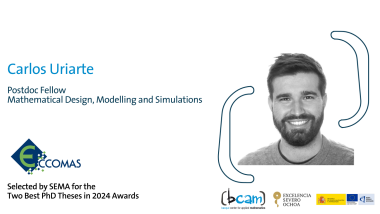- Debido a la situación causada por la pandemia de COVID-19 la defensa se llevará a cabo en línea y será retransmitida en directo
Mikel Agirre se licenció en matemáticas en la Universidad del País Vasco en 2013. En 2014 obtuvo un máster en Matemáticas de la Universidad de Copenhague (Dinamarca).
En 2015 se unió al Basque Center for Applied Mathematics - BCAM como estudiante de doctorado dentro de la línea de investigación de Ondas Lineales y No Lineales. Desde 2018 trabaja como profesor en la Universidad de Mondragón.
Su tesis doctoral, The Schrödinger equation and Uncertainty Principles, ha sido supervisada por el profesor Luis Vega (BCAM-UPV/EHU).
Debido a la situación causada por la pandemia de COVID-19 la defensa se llevará a cabo en línea y será retransmitida en directo a través de la plataforma BB-Collaborate. Tendrá lugar el
miércoles 2 de septiembre a las 16:00 horas, y los usuarios podrán seguirla en directo a través del siguiente enlace:
https://eu.bbcollab.com/collab/ui/session/guest/8a92de55f8f64f1bba169a2758a2e895
En nombre de todos los miembros de BCAM, nos gustaría desear a Mikel la mejor de las suertes en la defensa de su tesis.
[idea]
PhD thesis Title: The Schrödinger equation and Uncertainty Principles
The main task of this thesis is the analysis of the initial data u0 of Schrödinger’s initial value problem in order to determine certain properties of its dynamical evolution.
First we consider the elliptic Schrödinger problem in its perturbative form. The idea is to find lower bounds for the solution giving conditions at time t = 0 together with a size condition on the potential. After analyzing the elliptic case we give a similar result for the hyperbolic Schrödinger operator.
Next we focus on the free particle case, this is, the case where no potential is involved. The goal here is to quantify the L2 norm of the solution in a space-time cylinder. Following the same idea as before we want to find conditions at time t = 0 to ensure this. To carry out this task we define the Σδ space where δ is a parameter on the interval (0, 1]. We see that if u0 belongs in this space then so does its evolution in time and use this fact to give lower bounds for the L2 norm of the solution. For δ = 1 we give a different approach and make use of the Virial Theorem. We will see that this case has particular properties.
Finally we study dynamical uncertainty principles derived from the previous study. The key point will be to write the solution as u = ρeiϴ, where ρ and ϴ are real functions. Thus we give uncertainty principles in terms of these functions and find explicit expressions for them so that u becomes a minimizer of the problem.
[/idea]




